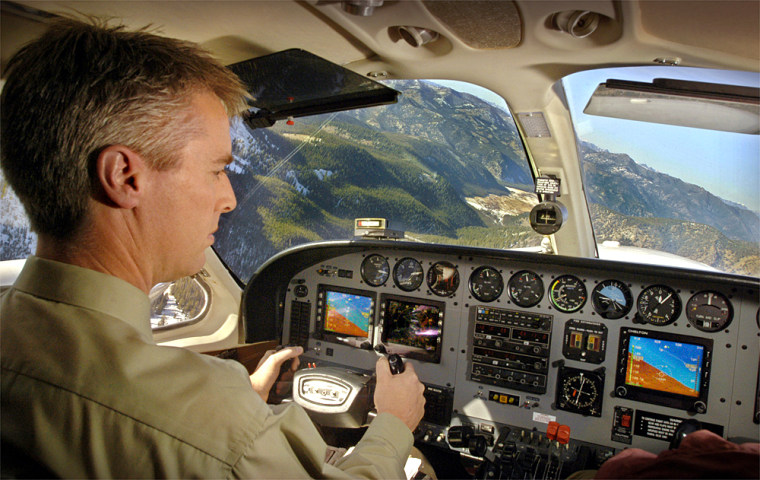A new flight computer being marketed to pilots of small aircraft allows them to see through clouds, haze or dense fog, potentially eliminating the kind of disorientation that resulted in 159 fatalities over the last six years.
The computer designed by Chelton Flight Systems gives pilots a real-time, "synthetic" view of everything they need to fly the plane safely. That's important when the view out of the cockpit windows turn oatmeal gray, the plane bounces blindly though turbulent air and it's impossible to tell whether the aircraft is aimed up or down.
Even a quiet, overcast night sky in a remote area can be disorienting.
"Losing track of the airplane is what gets most pilots into trouble," said Gordon Pratt, president of the Boise-based company and co-developer of the FlightLogic system, which was designed for private and small commercial aircraft.
In flight school, pilots are taught that spatial disorientation comes when the body's own internal gyroscope is fooled when there is no stable, visible horizon. Gravitational forces from the aircraft create false feelings of motion and belie the plane's actual movement.
Instructor pilots often show their students this phenomenon by having them close their eyes while the aircraft is flying straight and level. The instructor slowly and gently maneuvers the aircraft into a steep dive. When the student opens his eyes, he is shocked to see the earth at a displaced 70-degree angle.
Pilot disorientation caused at least 72 small aircraft crashes between 1998 and 2003, according to the National Transportation Safety Board. Such crashes resulted in 159 deaths, including that of John F. Kennedy Jr., his wife and her sister in 1999.
Crashes of small commercial carriers were not factored and some cases from later years may still be under investigation and not reflected in the data, NTSB spokesman Paul Schlamm said.
The evolution of cockpit instrumentation has presented pilots with an increasingly complicated array of dials and gauges. Instrument-certified pilots are trained to assemble the pieces of data into a complete mental picture of what's happening to the aircraft.
'It's way different'
The FlightLogic system processes all the aircraft's flight information along with pre-loaded data about the nearby terrain, and pinpoints location data from Global Positioning System satellites. The data are melded into one intuitive picture and projected on a video display screen about the size of paperback novel.
"The biggest advantage is everything is on one display. Normally it's six (instruments), and you're comparing them all in your head. It takes a lot more time and brain processing. With Chelton, it's a three-dimensional quick glance," said Chad Menne, a 29-year-old Minneapolis instructor with nine years of experience as a pilot.
"It looks almost like a video game," he said. "It's way different from what aviation has been for the last hundred years."
Pratt said the system is not meant to be installed in all the 188,000 active planes in the United States. He's targeting the 20,000 to 25,000 owners of small planes _ the doctors, lawyers and business owners who fly occasionally but whose skills could benefit from a flight computer.
A $75,000 Chelton avionics package, about the middle of the price range, comes with two screens to create what the company calls "synthetic vision."
The left screen shows a forward-looking, 70-degree view of the horizon and the terrain ahead, along with the aircraft's compass heading, speed and altitude. People can see only about 45 degrees, so it nearly doubles a pilot's natural view.
The left screen is also used for navigation. The pilot can select a destination, such as an airport, and the display will show a series of artificial green boxes, each representing a 400-foot-wide target in the sky. The boxes line up to form a tunnel toward the destination airport. Aim the plane through the boxes and the runway will appear under the landing gear. Or, if a pilot prefers, the interfaced autopilot can do the same thing, including complicated instrument landing approaches.
The right screen is a top-down view of the aircraft's location on a moving map, showing exact location, along with any nearby air traffic or airports. Even tall obstructions, such as radio towers, are clearly mapped out.
The FlightLogic computer comes with back-up electronics to prevent failure.
Replacing old systems
Pratt and a friend, former Navy test pilot Rick Price, started developing the system together in 1996.
"I was building an airplane of my own and I was looking at an instrument panel that was designed in the 1940s," said the 38-year-old Pratt, who has been flying 15 years.
Pratt and Price formed Sierra Flight Systems, with Price writing most of the computer code in his spare time during law school.
As development continued, the partners found the ground terrain display, which is modeled on United States Geographical Service maps, was actually too realistic.
"We actually had to dumb-down the detail," Pratt said.
Sierra later merged with Chelton Group, an existing aeronautical communication and navigational equipment producer, and became Chelton Flight Systems. The new partnership sold its first experimental unit in 1999 and the system was approved by the Federal Aviation Administration for general sales and installation in March.
To date, the company has sold about 750 systems.
